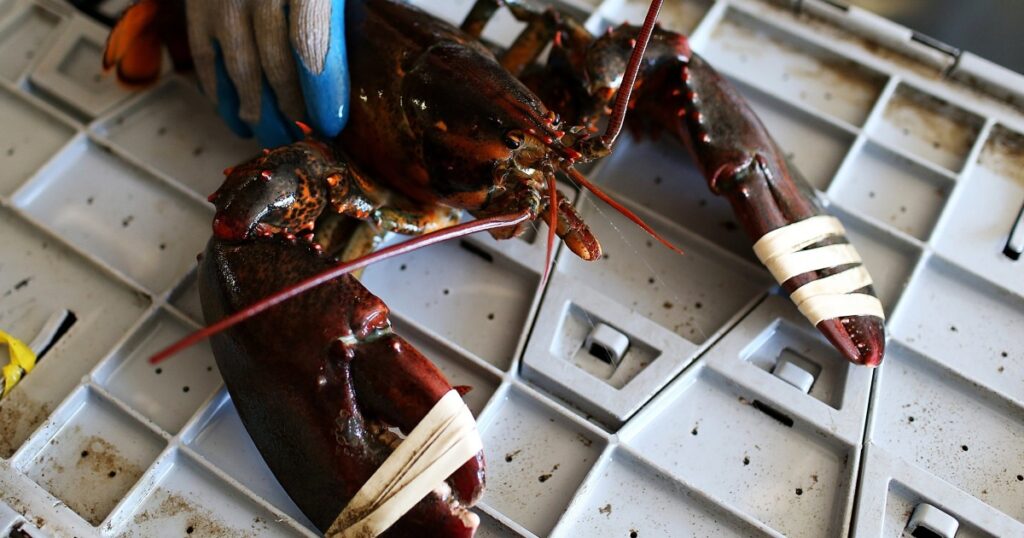PORTLAND, Maine — In his three decades on the water, Jerry Cushman has seen Maine’s iconic lobster industry weather numerous threats, but while the latest challenge may sound like a small one, it could be the biggest yet.
Lobster fishing is a game of inches, but those inches are changing: Fisheries regulators are enacting new rules that mean lobstermen must more strictly adhere to the minimum size of the crustaceans they catch.
The impending change may be just 1/16 of an inch (1.6 millimeters) but will make a big difference for a fishery already facing major threats from climate change and new rules to protect whales, many lobstermen told The Associated Press.
But interstate fishing regulators say the change is necessary to protect the future of lobster populations off New England’s coast as warmer ocean temperatures cause lobsters to move further north.
The changes have sparked controversy among fishermen and regulators, as well as confusion about their impact on international trade in one of the world’s most popular seafood.
“We really don’t need any more of this, just fight after fight,” said Cushman, 55, a boat captain who fishes out of Port Clyde. “We don’t need anything to bring lobster prices down in the market.”
Fishermen oppose the new rules, which are set to go into effect next summer, because they fear that even such small changes could dramatically alter fishing capacity. They also say they will be at a disadvantage in competition with Canada, which fishes for the same species of lobster and has looser rules. Some worry that the size changes could lead to a glut of lobsters on the market for years to come.
But recent surveys have shown declining numbers of juvenile lobsters off the coast of Maine, and regulators with the Atlantic States Marine Fisheries Commission say that could be a sign of declining catches.
“We’re seeing declines in new recruits, which will likely lead to declines in adult populations in the future,” said Caitlin Starks, the commission’s senior fisheries management plan coordinator.
America’s lobster catch is already in decline: The Maine state, which harvests most of the nation’s lobsters, saw its catch fall from a high of 132.6 million pounds in 2016 to 93.7 million pounds last year.
Fishermen catch lobsters off the coast of Sprucehead, Maine. Robert F. Bukaty/AP File
The minimum size change applies to the Gulf of Maine, a body of water off the coast of New England that is one of the most important lobster fishing grounds in the world. Under commission rules, the legal catch size for lobsters there would change if the gulf’s young lobster population declined by 35 percent.
The agency said last year that fish stocks were down 39% in 2020-22 compared with 2016-18, a figure that surprised both regulators and fishermen and led many to question the accuracy of the commission’s data.
Still, regulators say the minimum size of the gauges fishermen use to measure lobsters will rise to 3 5/16 inches (8.4 centimeters) on July 1, then grow another 1/16 inch two years later.
Some conservationists support the change because they believe it will prevent lobster populations from declining due to overfishing. “This is especially important as we experience unprecedented climate change in the Gulf of Maine,” said Erica Fuller, an attorney with the Conservation Law Foundation’s marine program.
Scientists say the Gulf of Mexico is warming more rapidly than most of the world’s oceans.
“The analysis reveals that the proposed cage size expansion would increase spawning population biomass and contribute to the long-term health and resilience of lobster populations,” Fuller said.
The change would not apply to Canada, which has an even larger lobster fishery than the U.S., and some Canadian fisheries already allow the catch of smaller lobsters than U.S. regulations allow.
Canadian authorities and industry groups closely monitor U.S. regulatory actions
This month, the Atlantic Provinces Commission approved new rules to prevent the U.S. from importing sub-legal lobsters from Canada. The Canadian government is “committed to working with Canada’s fishing industry to ensure continued market access,” said Burle Campbell, a spokesman for Fisheries and Oceans Canada.
Not being able to sell lobsters to the United States could force Canada to become more reliant on other overseas markets, said Jeff Irvine, executive director of the Canadian Lobstermen’s Association. China is a major buyer for both countries.
“If we can’t sell a certain percentage of lobsters that size to the United States, we have to find somewhere to sell them,” Irvine said. “How does that affect prices? What does that mean for fishermen?”
Longtime seafood analyst John Sacton said the changes will likely have a big impact on the lobster industry but may not trickle down to U.S. consumers. Trade data shows prices have been lower this summer than in recent years. Whether that continues will depend in part on the size of the catch for the rest of the year, Sacton said.
Some scientists who study the fishery support the change in minimum size. Richard Wall, a former professor of marine science at the University of Maine who has studied lobsters for decades, called it a “sensible” step to protect the future of the fishery.
But the lobster industry sees it differently, said Patrice McCarron, executive director of the Maine Lobstermen’s Association, the oldest and largest fishing association on the East Coast.
The association believes that such measures are not necessary at this time.
While recent lobster catches have declined since the 2010s, they are still far higher than in previous decades, the group argued in committee testimony, and lobstermen also face “significant regulatory uncertainty from future whaling restrictions.”
Rep. Jared Golden, a Democrat who represents coastal Maine, proposed an amendment in July to block the sizing change.
“It’s clear that regulators need to work more closely with fishers to keep our fisheries sustainable and competitive,” Golden said.




1 Comment
Muchas gracias. ?Como puedo iniciar sesion?